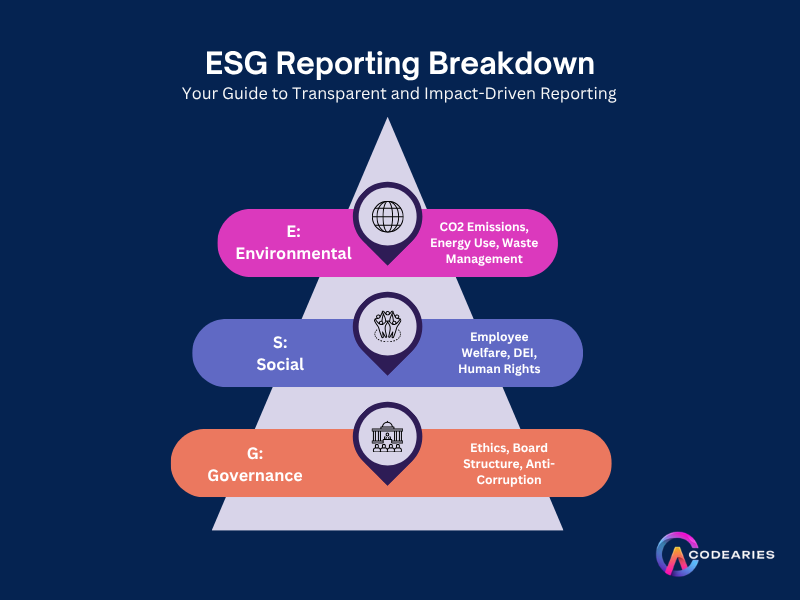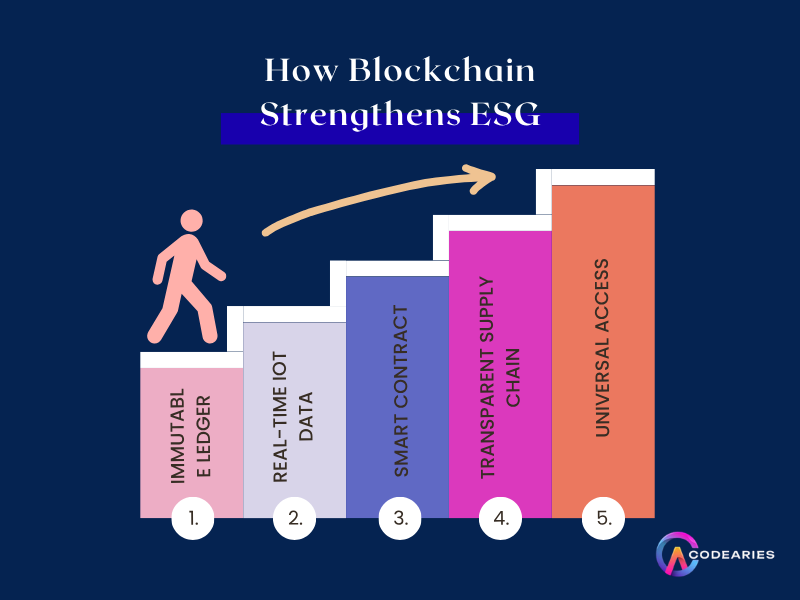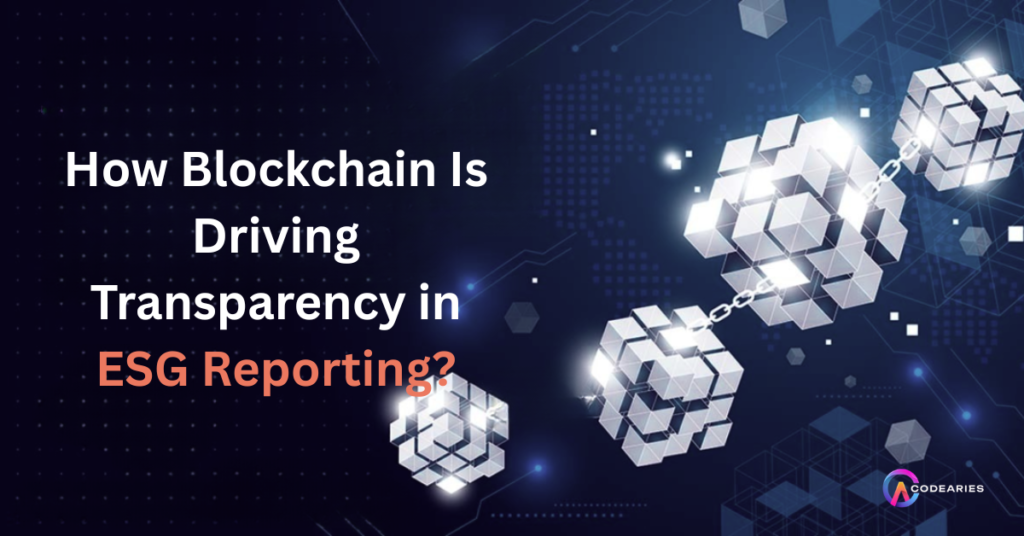In today’s purpose-driven economy, Environmental, Social, and Governance (ESG) factors are no longer just an added bonus; they are now strategic, regulated, and demanded by investors, consumers, and regulators. Companies must act ethically, sustainably, and transparently, and they need to prove it.
However, traditional ESG reporting has serious problems. It is full of inconsistencies and relies on manual processes, leading to greenwashing.
Companies often self-report ESG metrics without any verification, resulting in reports that can be outdated, incomplete, or misleading. This gap between reported information and reality erodes stakeholder trust.
Here’s where blockchain technology comes in, offering a strong solution. It provides a secure, transparent, and tamper-proof system for recording, verifying, and sharing ESG data.
In this blog, we’ll look at how blockchain is changing ESG reporting, real-world applications, and how your business can lead the way in sustainable accountability with the right partner.
What Is ESG Reporting?
ESG reporting involves disclosing non-financial metrics that define a company’s ethical, environmental, and governance performance. It encompasses three key areas:
- Environmental: Carbon footprint, energy usage, emissions, waste
- Social: Employee well-being, diversity, human rights, community impact
- Governance: Board structure, anti-corruption, executive pay, ethics
These metrics influence investor decisions, consumer trust, and regulatory compliance frameworks like the EU’s CSRD, SEC ESG disclosures, and the UN’s Sustainable Development Goals (SDGs).

The Problem with Existing ESG Systems
| Challenge | Result |
| Lack of standardization | Inconsistent ESG reports between companies and industries |
| Manual data collection | Prone to errors, delays, and manipulation |
| Limited traceability | Stakeholders can’t verify data accuracy or origin |
| Greenwashing | Companies overstate sustainability claims without proof |
Without verification and traceability, stakeholders must rely on trust instead of truth. This approach no longer stands up to scrutiny.
Enter Blockchain: Built for Transparency
Blockchain is a decentralized digital ledger that records transactions in real-time. It is tamper-proof, transparent, and auditable, making it ideal for ensuring ESG data integrity.
| ESG Reporting Problem | Blockchain Solution |
| Data manipulation | Immutable, timestamped records |
| Delayed visibility | Real-time smart contract data |
| Conflicting reports | Shared truth across stakeholders |
| Supplier compliance | Traceable ESG data across chain |
How Blockchain Strengthens ESG Reporting
1. Immutable Record-Keeping
Data stored on the blockchain cannot be altered. This capability helps companies show that reported metrics, like CO2 levels or waste reduction, are real and verifiable.
Example: A renewable energy firm logs daily emissions data to the blockchain to satisfy real-time carbon reporting requirements.
2. IoT + Real-Time Data Capture
Sensors and IoT devices send ESG data, such as energy usage and emissions levels, directly into blockchain networks for immediate environmental auditing.
Use Case: Smart water meters tracking industrial water consumption across several factories.
3. Smart Contract Automation
Smart contracts can automatically implement ESG rules:
- Release reports quarterly
- Flag ESG violations
- Enforce conditional payments based on compliance
Scenario: If a supplier fails to meet DEI benchmarks, procurement transactions are automatically paused.
4. Supply Chain Transparency
Blockchain guarantees that claims of ethical sourcing are traceable and verifiable throughout the supply chain.
Example: Coffee beans verified from farm to cup using traceable smart tags linked to the blockchain, such as IBM Food Trust and Everledger.
5. Universal Stakeholder Access
All parties, including investors, regulators, and consumers, can access the same verified ESG data. No spreadsheets and no filtered narratives.
Outcome: Everyone sees one verified truth, leading to fewer disputes and greater stakeholder confidence.

Real-World Use Cases
| Company/Project | Application |
| EY | Blockchain tools for verified GHG emissions tracking |
| Circularise | Tracks material origin and ethical sourcing for manufacturers |
| Shell + Energy Web | Verifies renewable energy certificates via blockchain |
| CarbonX | Tokenizes carbon offsets for individuals and enterprises to purchase and track in real-time |
Benefits of Blockchain-Enabled ESG
Investor Confidence:
Investors obtain tamper-proof evidence of ESG performance.
Audit-Ready Compliance:
Immutable records simplify auditing and more effectively meet SEC, EU, and UN requirements.
Operational Efficiency:
Decrease the time spent on reporting, compliance checks, and manual verification.
Brand Differentiation:
Companies that prove sustainability attract loyal customers and have better recruitment appeal.
Proactive Risk Management:
Real-time alerts help identify ESG violations before they harm reputations.
How Codearies Helps Companies Build Blockchain-Powered ESG Solutions
At Codearies, we assist organizations in achieving ESG transparency through scalable, secure, and customizable blockchain solutions.
Whether you want to create a climate-first product, comply with new ESG mandates, or protect your supply chain, you need a reliable partner to turn your vision into reality.
What Codearies Offers:
Blockchain-Based ESG Dashboards:
Real-time, investor-ready platforms built with secure data flows and user-friendly visualization tools.
Smart Contract Automation for ESG Triggers:
Automatically track targets, trigger audits, or halt transactions if compliance thresholds are not met.
Supply Chain Sustainability Systems:
Verify ESG compliance from raw material extraction to final delivery, confirmed across all suppliers and partners.
IoT-to-Blockchain Integration:
Gather emissions, energy, water use, and workplace data from sensors that feed into blockchain networks.
Hybrid Data Architecture:
Manage large ESG datasets with a mix of on-chain verification and off-chain storage for efficiency.
Custom Smart ESG Frameworks:
Tailored solutions that meet your industry’s specific ESG metrics and compliance requirements.
Frequently Asked Questions (FAQ)
Is blockchain data on ESG reports publicly accessible?
Yes, if designed that way. Codearies can create private or public chains based on your needs and compliance requirements.
Can blockchain work with existing ESG frameworks (GRI, SASB, CSRD)?
Absolutely. Our systems are built to align with global ESG standards and allow for custom implementation around your current compliance practices.
Is it possible to track scope 1, 2, and 3 emissions using blockchain?
Yes. By using IoT and third-party integrations, blockchain can trace emissions through supply chains, helping companies automate their Scope 1 to 3 disclosures.
Won’t storing large ESG data require huge on-chain storage?
Not really. Codearies uses hybrid models, where data is stored off-chain and verified on-chain for cost-effectiveness.
We’re not a tech company. Is blockchain implementation difficult?
We make the entire process simple—from consulting and design to deployment and support—so CSR and compliance teams don’t need to understand technical jargon to use it.







